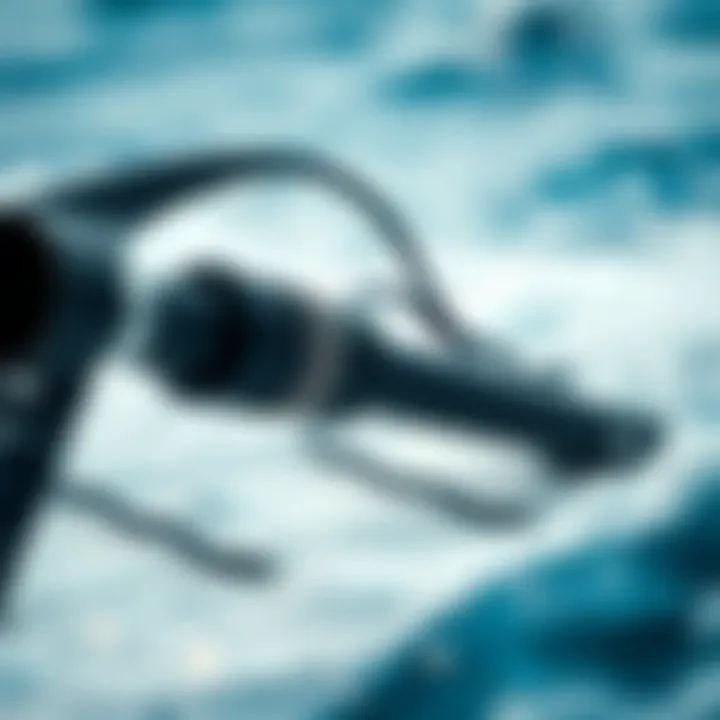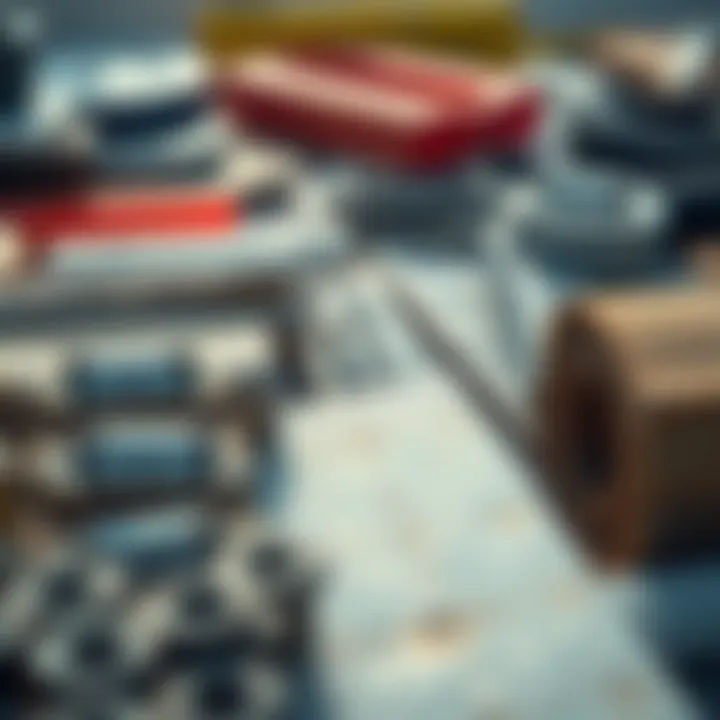Understanding Electric Hydrofoil Pricing Dynamics


Intro
Electric hydrofoils have steadily entered the spotlight in the kiteboarding scene, revolutionizing the way enthusiasts interact with water sports. As these innovative boards glide above the surface, offering a unique experience that feels almost otherworldly, a significant question often arises: why do electric hydrofoils come with price tags that can feel a bit hefty?
With a growing range of options available, understanding the factors that influence pricing is crucial for anyone considering investing in this advanced equipment. It’s not merely about the brand name or the latest technology; a plethora of elements contribute to the overall cost, encompassing construction materials, design intricacies, and even market behavior. For enthusiasts at every skill level, knowing what affects pricing can lead to more informed decisions when purchasing or upgrading gear.
The aim of this article is not to merely skim the surface, but to dive in deep. We will explore essential elements like the materials used in the construction of electric hydrofoils, advancements in technology, brand prestige, and the dynamics of supply and demand. Alongside this, we will discuss the implications of these price variations for both seasoned kiteboarders and newcomers alike. Thus, whether you are a hardcore kiteboarding aficionado or a curious beginner, the insights here will help to illuminate the sometimes murky waters of electric hydrofoil pricing.
Prolusion to Electric Hydrofoils
Electric hydrofoils are an exciting advancement in the world of water sports, particularly in the kiteboarding community. With these innovative crafts, riders can glide effortlessly above the surface of the water, combining the thrill of flying with the serenity of cruising over waves. This section serves as a foundational introduction, helping readers appreciate the significance of electric hydrofoils, their benefits, and the considerations that come with them.
Defining Electric Hydrofoils
Electric hydrofoils are essentially surfboards or kiteboards equipped with a hydrofoil and an electric motor. The hydrofoil is a lift-generating structure that extends below the water’s surface, elevating the board—and the rider—above the water. This design minimizes drag and allows for smoother rides, allowing kiteboarders to harness wind and waves more effectively.
But what sets electric hydrofoils apart from traditional hydrofoils? The integration of electric motors provides the capability of powered flight. Riders can venture farther with ease, without needing consistent wind conditions. This has opened up possibilities for exploration and enjoyment in a variety of environments.
The Principle of Hydrofoiling
The principle behind hydrofoiling is fascinating and rooted in physics. When a hydrofoil is submerged and a certain velocity is achieved, water flowing over the wings generates lift, acting similarly to how airplane wings create lift in the air. As speed increases, the lift can elevate the board above the water. This results not just in a unique sensation for the rider but also reduces the energy lost to waves and water resistance.
Typically, a rider will attain sufficient speed to get airborne by a gentle flick of the kite during kiteboarding. Due to the nature of the electric motor, combinations of wind and electric propulsion can significantly enhance the speed and control that kiteboarders experience.
While the initial investment in an electric hydrofoil may be steep, the joy it brings can be unmatched. Unlike traditional kiteboarding, where conditions dictate rideability, these boards often allow for riding on calmer days and expand the window of usability immensely. Moreover, once riders understand the mechanics of hydrofoiling, they often find themselves enamored by its thrilling nature.
In summary, electric hydrofoils marry traditional kiteboarding with innovative technologies, paving the way for a fresh experience on the water. As the following sections unfold, readers will gain insights into the market dynamics shaping pricing, alongside the detailed factors influencing the costs of these modern marvels.
"Electric hydrofoils are not just a trend; they represent the future of water sports, where technology meets performance."
Expanding on this foundation, we will delve deeper into the current market trends and what influences pricing in the world of electric hydrofoils.
Market Overview
The electric hydrofoil market is a fascinating landscape that reflects broader trends in both water sports and technological innovation. Understanding the current market dynamics is essential for both buyers and sellers. This section examines not only the demands shaping the pricing but also the competitive factors at play. Knowing these elements can influence purchasing decisions and help enthusiasts select the right product for their needs.
Current Demand in Kiteboarding
In recent years, kiteboarding has surged in popularity, particularly among adventure seekers looking for new ways to experience the thrill of the water. As a result, electric hydrofoils have found their niche in this expanding market. The demand for electric hydrofoils is closely tied to several factors:
- Accessibility: More people are venturing into kiteboarding, drawn by the allure of smooth rides and the sensation of flying above water.
- Increased Awareness: With a growing number of online communities and forums, such as Reddit and social media platforms like Facebook, kiteboarders are more informed than ever. They share experiences, tips, and recommendations, fueling interest in electric hydrofoils.
- Technological Integration: The advent of user-friendly designs and safety features has made electric hydrofoils a more viable option for novices, encouraging them to transition to electric riding.
Ultimately, the rise in demand for electric hydrofoils does not merely rest on sales figures; it stems from a burgeoning community of enthusiasts who are shaping the future of this sport.
Competitive Landscape
Navigating the competitive landscape of electric hydrofoils can feel like sailing through uncharted waters. Manufacturers and brands range from established names to newer entrants, each vying for market share through innovation and distinct offerings. Competitiveness in this market hinges on several key elements:
- Brand Reputation: Established brands often command higher prices due to their proven track record. Buyers might feel reassured knowing they are purchasing from brands recognized for quality and reliability.
- Product Features: Differentiation often comes down to performance attributes like battery life, speed, and stability. A hydrofoil that provides superior performance in rough conditions can stand out significantly against competitors.
- Distribution Channels: Companies utilizing direct-to-consumer sales models can offer competitive pricing compared to those relying on traditional retailing methods. By bypassing intermediaries, some brands manage to retain robust profit margins while extending better prices to customers.
"The competition in the electric hydrofoil market is not just about prices; it's about how well a brand meets the unique demands of kiteboarders."
As kiteboarding enthusiasts continue to explore the thrilling world of electric hydrofoils, they will find that the market is ever-evolving. Understanding this dynamic environment not only helps in making informed purchasing decisions but also enriches the overall experience of this exhilarating sport.
Key Factors Influencing Pricing
Understanding the pricing structure of electric hydrofoils requires delving into several key factors. These elements do not merely affect the cost, but they play a pivotal role in defining the value these watercraft offer to enthusiasts. Factors such as materials and construction, technological innovations, and brand reputation stand out prominently. Each of these factors contributes not only to the overall quality of hydrofoils but also to the user experience, making them essential considerations for anyone in the market for this exciting equipment.


Materials and Construction
The materials used in the construction of electric hydrofoils can spell significant differences in both performance and price. Lightweight yet durable materials like carbon fiber or high-grade aluminum alloys are often favoured for their strength-to-weight ratios. On the flip side, some manufacturers might opt for more budget-friendly options such as fiberglass, which can lead to a lower price point but may compromise performance.
- Carbon Fiber: Offers superior strength and minimal weight, enhancing acceleration and maneuverability.
- Aluminum Alloys: Durable and relatively lightweight, but not as performance-oriented as carbon fiber.
- Fiberglass: Generally less expensive and heavier; suitable for beginners but may not hold up as well under rough conditions.
A hydrofoil's construction can also impact its assembly complexity. For instance, a model that requires sophisticated engineering may have a higher manufacturing cost, ultimately reflected in its price tag. Understanding the trade-offs between material choices is key for consumers who must choose between durability, weight, and budget.
Technological Innovations
The technological features embedded within electric hydrofoils have a profound impact on their pricing. For instance, advancements in battery technology and motor efficiency are game changers in this space. Electric hydrofoils equipped with high-capacity, lightweight batteries allow for longer rides and quicker charging times, justifying a premium price.
Some factors to consider include:
- Battery Life: More efficient batteries improve ride duration and overall experience.
- Motor Efficiency: Advanced motors that consume less power can reduce operational costs in the long run.
- Advanced Controls: Features like digital displays and smart technology can increase safety and improve control, also contributing to higher costs.
The ongoing research and development in these areas mean consumers will likely see prices shift with the introduction of the latest technologies. Those looking for cutting-edge performance might pay a premium now, only to benefit from evolving tech as it becomes mainstream.
Brand Reputation
Brand reputation stands as a significant influence on pricing, particularly in niche markets such as electric hydrofoiling. Well-known brands like Lift Foils and Takuma often command higher prices due to perceived reliability and quality assurance. Their decades-long history in watersports lends credibility, whereas new or lesser-known brands may offer lower prices to attract early adopters.
Factors to consider with brand reputation:
- Trust and Reliability: Established brands usually have extensive customer service networks and warranties.
- Customer Reviews: Feedback from past users plays an essential role in influencing potential buyers.
- Market Position: Brands known for premium offerings may set higher price points, knowing their products are in demand.
Ultimately, the brand you choose can greatly affect the perceived value and longevity of your investment in an electric hydrofoil. A buyer must weigh the assurance that comes with a reputable brand against potential savings from lesser-known options.
In summary, materials and construction, technological advancements, and brand reputation all create a nuanced landscape concerning electric hydrofoil pricing. Each factor carries its weight and should be carefully considered by anyone keen on diving into this exhilarating sport.
Price Ranges of Electric Hydrofoils
Understanding the pricing structure of electric hydrofoils is crucial for potential buyers, especially in the growing kiteboarding market. The variation in price ranges reflects not only the differences in features and technologies but also the expectations and experiences that come with each type of hydrofoil. Knowing the different categories—and their respective price points—can help enthusiasts, from beginners to seasoned riders, make informed decisions based on their budget and riding style.
Entry-Level Options
For those just dipping their toes into the world of electric hydrofoiling, entry-level options present an attractive option. Generally, these can be found in the price range of $3,000 to $5,000. These models often prioritize affordability while providing a solid introduction to the sport.
Some characteristics of entry-level hydrofoils include:
- Simplified Designs: Often designed without too many complex features, making them easier to use for first-timers.
- Basic Battery Packs: While sufficient for short rides, the battery life may require consideration when planning longer outings.
- Durability Considerations: Usually made from more cost-effective materials, yet robust enough for novice-level usage.
Many first-time riders might find brands like Lift Foils or Fliteboard offer good options within this tier. Investing in an entry-level hydrofoil allows beginners to learn the basics without breaking the bank.
Mid-Range Choices
As riders become more committed to the sport, they might find themselves eyeing the mid-range choices, typically priced between $5,000 and $9,000. These products often strike a balance between performance and affordability, catering to enthusiasts ready for a deeper engagement.
Key features often seen in mid-range models are:
- Improved Build Quality: Enhanced materials meant to withstand a bit more wear and tear while providing a more satisfying ride.
- Better Battery Life: These models tend to come equipped with advanced battery packs that offer longer ride times, making them suitable for day trips.
- More Advanced Features: Many mid-range hydrofoils include customizable performance options, catering to those who wish to enhance their riding experience.
Riders looking to up their game might find brands like Neutrino or Tiwal resonate well with the needs of this group. Mid-range hydrofoils could serve both leisure purposes and more enthusiastic riding styles, creating a balance tailored to the mellow and adrenaline-filled moments alike.
High-End Models
For those who seek cutting-edge technology and superior performance, high-end models fall into the price bracket of $9,000 and above. Designed for serious athletes, these hydrofoils come packed with state-of-the-art features and performance enhancements that justify their premium price tag.
High-end models typically showcase:


- Advanced Materials: Often made with carbon fiber and other lightweight yet durable compositions for enhanced speed and agility.
- Sophisticated Battery Technology: High-end options often feature advanced battery management systems, offering extended ride times and better efficiency.
- Custom Performance Profiles: Options for personalizing the ride settings to match vastly different styles, including racing or leisurely rides are common.
Brands such as eFoil from Lift or the extravagant models by K-SURF provide thrilling experiences. For dedicated kiteboarders who view hydrofoiling as more than just a hobby, investing in a high-end model can elevate their sessions to an entirely new level of excitement and satisfaction.
In summary, knowing the price ranges of electric hydrofoils can empower enthusiasts to choose models that align with their skills and budget while ensuring they get the most out of their kiteboarding adventures.
For more detailed insights into electric hydrofoils and market trends, you might find the following resources helpful:
- Wikipedia on Hydrofoils
- Britannica on Kiteboarding
- Reddit discussions on Hydrofoiling
- Official hydrofoil product reviews
- Government reports on maritime sports
- Educational insights on surfing and kiteboarding
Empowered with this knowledge, riders can navigate the electric hydrofoil market with confidence.
Economic Influences on Pricing
In the swiftly evolving world of electric hydrofoils, understanding the economic influences on pricing is imperative. The costs associated with these sophisticated devices are not simply a reflection of the materials used or the latest technological gadgets; they are intricately interwoven with broader economic factors. When it comes to kiteboarding enthusiasts, knowing these factors can make a significant difference in their purchasing decisions.
Supply Chain Factors
The supply chain remains a critical player in determining the final price of electric hydrofoils. From the moment raw materials are extracted until the product reaches the local retailer, a series of costs accumulate. This journey involves multiple stakeholders including manufacturers, transporters, and retailers.
- Material Availability: If components like lightweight carbon fiber or lithium batteries are in short supply due to global shortages or natural disasters, prices can skyrocket. The cost of acquiring these materials often trickles down to the consumer.
- Labor Costs: As wages rise in manufacturing hubs, companies may pass those expenses onto buyers. Lower production costs in regions with cheaper labor can lead to more competitive pricing in emerging markets.
- Logistics and Transportation: Fluctuations in shipping rates, especially those affected by fuel prices or political events, have a tangible impact on product pricing. Increased shipping costs can abruptly change what consumers pay for electric hydrofoils, especially for those imported from foreign manufacturers.
A considerable takeaway here is that as global economic conditions shift, so do the fortunes of supply chains. For consumers, keeping tabs on economic indicators can provide insights into when to make their purchase decisions.
Market Demand Shifts
Market dynamics often shift based on a variety of external influences—from seasonal trends to sudden spikes in consumer interest. The kiteboarding community, passionate and growing, is often susceptible to these fluctuations.
- Seasonal Trends: Prices typically surge during peak kiteboarding season—late spring to early fall in many regions. Conversely, during off-season, prices might drop and give savvy shoppers an opportunity to snag a deal.
- Emerging Technologies: As new and more efficient designs hit the shelves, demand for previous models may wane, impacting their prices. Enthusiasts eager for the latest features often find themselves paying premium prices, while those willing to settle for a previous version can benefit from reduced costs.
- Promotional Events and Marketing Strategies: Sales events, like Black Friday or end-of-season sales, can temporarily skew market prices. Companies often anticipate a boost in volume during these periods and may adjust pricing to be more attractive, tapping into the heightened demand.
In summation, understanding the economic tides that influence electric hydrofoil pricing helps consumers navigate the choppy waters of investment. Whether it's taking note of supply chain logistics or being aware of shifting market demands, these insights pay off in making informed buying choices. Each decision can mean the difference between overpaying for a vapid trend or investing in a solid piece of technology that enhances the kiteboarding experience, blending excitement with the allure of water sports.
"Knowledge of economic influences on pricing not only empowers consumers but also enriches their overall experience with the sport."
For anyone entrenched in the kiteboarding scene or just dipping their toes in, the convergence of economics and sport is worth paying attention to.
Regional Price Variances
In the world of electric hydrofoils, regional price variances reveal crucial insights into how geographical and economic factors influence the cost of these innovative watercraft. Understanding these variances isn't just an exercise in numbers; it's about grasping how local markets, consumer demand, and even local laws can dictate pricing. This section sheds light on why two identical hydrofoils may carry vastly different price tags based on where they are sold. Additionally, it helps potential buyers make more informed decisions tailored to their specific markets.
North American Market Trends
In North America, the market for electric hydrofoils has recently been experiencing a surge in interest. This increase in consumer enthusiasm comes largely from a growing culture of water sports and adventure activities. Consequently, prices here tend to be rooted in the competition among suppliers while also reflecting the expenditures associated with shipping and retail operations.
Unofficially, the presence of high-end brands like Lift Foils and Fliteboard have led to the establishment of a premium segment. Hydrofoils in the U.S. can range from $5,000 to over $12,000, considerably influenced by the state of the economy, disposable incomes, and the propping up of technology advancements. Additionally, taxes and tariffs can contribute significantly, making local pricing a tricky affair. As noted on forums such as Reddit, enthusiasts often discuss these variances, noting that prices can fluctuate wildly even within states.
European Market Insights
Moving across the pond to Europe, the market trends reflect a blend of tradition and innovation. In countries like France and Spain, where water sports are deeply ingrained in local culture, the demand for electric hydrofoils mirrors the region's vacation economy. Price points can be slightly lower compared to North America due to VAT regulations and the prevalence of local manufacturers who understand consumer preferences better.
However, the European market isn't without its complexities. For instance, the prices in Northern European countries like Norway and Sweden generally trend higher due to factors such as shipping costs and import duties. A striking observation is that many local brands are emerging, leading to a burgeoning mid-tier segment. As industry conversations reveal, the capability for customization in European models can rally interest, translating to premium pricing for bespoke solutions.
Asian Market Dynamics
Asia presents a unique tapestry of trends when it comes to electric hydrofoil pricing. Countries like Japan and Thailand are adopting hydrofoiling at an astonishing rate, fueling market growth. Unlike other regions, Asian markets often display lower entry prices primarily due to competitive pricing tactics and a significant influx of manufacturers looking to capture a slice of the pie.
Despite this, quality remains a focal point. Chinese companies like Wuxi Yuhuang have made strides in producing cost-effective hydrofoils that do not compromise on performance. This has led to a price range of $3,000 to $6,000, appealing to both entry-level users and seasoned riders alike. Moreover, regional variances are also highlighted in topics regarding import tariffs and specific boating regulations prevalent in nations like Singapore or the Philippines.


"The essence of pricing in the electric hydrofoil market transcends beyond mere numbers; it embodies a confluence of culture, regulations, and lifestyle choices that vary remarkably across regions."
Local preferences dictate not only price but also the features buyers gravitate toward, making it imperative for enthusiasts and athletes to consider these factors to make an informed purchase. As a result, investment in understanding these regional dynamics ultimately fosters more confident buying decisions for everyone involved.
Impact of Technology on Pricing
The role of technology in determining the pricing of electric hydrofoils can't be overstated. In a market that's consistently evolving, innovation shapes consumer expectations and plays a significant part in driving costs. From battery advancements to enhanced motor efficiency, it all counts. As kiteboarders and enthusiasts seek better performance, technology leads the way, and naturally, these developments are reflected in the prices of electric hydrofoils.
Battery Technology and Costs
Battery technology is perhaps the backbone of electric hydrofoil pricing. The type of battery used can dramatically influence both the performance and the price of these watercraft. Lithium-ion batteries reign supreme here, prized for their lightweight and high energy density. This makes them the go-to choice for manufacturers aiming to create hydrofoils that offer longer ride times and quicker charging capabilities, both of which appeal to riders.
But here’s the rub: the more advanced the battery technology, the higher the cost. For example, hydrofoils equipped with top-tier lithium-polymer batteries cost significantly more than those using older technology or cheaper alternatives like lead-acid batteries. Moreover, maintenance costs and replacement frequency also play a role in the overall expense.
"Investing in high-quality battery technology is like putting fuel in a race car - it can mean the difference between first place and being left in the dust."
A well-crafted battery not only extends the life of an electric hydrofoil but is also crucial for providing a reliable and thrilling ride. Therefore, as manufacturers continue to innovate towards lighter, longer-lasting batteries, it inevitably raises the cost of the final product.
Motor Efficiency Developments
The motor is another key player in the pricing game. The efficiency of the motor directly affects how well an electric hydrofoil performs. Fewer losses in energy mean longer rides and less frequent recharging, which is a big draw for customers. To capture this market, many brands are now investing heavily in brushless DC motors known for their durability and efficiency.
While standard motors may suffice for beginners or those just dabbling in kiteboarding, avid enthusiasts often lean toward more sophisticated options, which naturally come at a premium price.
Here are some key aspects affecting motor prices:
- Efficiency Ratings: Higher efficiency means more speed with less energy, thus often pointing toward a higher initial investment.
- Material Quality: Premium materials enhance durability and performance but hike up costs. For instance, a motor using aerospace-grade aluminum will not just last longer but also run cooler, reflecting its price.
- Technological Integration: Motors that pair with sophisticated control systems, often featuring adjustable power outputs or smart technology, can drive prices through the roof.
As the technology progresses, one can only expect the competition to push for better, more efficient motors, thereby influencing pricing structures across the board. The costs associated with these advancements, while important, shed light on the values placed on quality, performance, and longevity in this thrilling sport.
Future Pricing Trends of Electric Hydrofoils
Understanding the future pricing trends of electric hydrofoils is crucial for anyone involved in the kiteboarding scene, be it seasoned riders or curious newcomers. The shifts in pricing are not just a reflection of market demand, but a broader response to increasing technological advancements, evolving customer expectations, and the wider economic climate. As we delve into these upcoming trends, it's vital to explore key elements that influence costs, including anticipated technological innovations and market forecasts that could reshape the accessibility and appeal of these cutting-edge devices.
Anticipated Technological Advancements
As we look ahead, we can expect a wave of technological enhancements that will impact the pricing of electric hydrofoils. Advancements in battery technology represent one of the most significant factors. For instance, manufacturers are innovating with lighter and more efficient batteries, which could enhance performance while reducing costs. This progress suggests that electric hydrofoils equipped with better battery systems may provide longer usage times on the water, an enticing prospect for enthusiasts who enjoy extended rides.
Additionally, the development of more energy-efficient motors continues to play a pivotal role. Motors that not only draw less energy but also boost speed and stability can lead to higher upfront costs but promise long-term savings for users, effectively rebalancing the scales of initial investment versus ongoing expenses. Moreover, advancements in materials science could also mean lighter yet more durable materials are being used in construction, leading to an overall enhancement in product value without a proportionate increase in price.
Market Forecasts
Looking at the market forecasts, it's clear that we might witness a robust increase in demand for electric hydrofoils over the next few years. The appeal of eco-friendly water sports is gathering momentum, potentially swelling the ranks of kiteboarding enthusiasts. As more riders take to the water, the economies of scale could apply, compelling manufacturers to streamline production processes and reduce prices in response to competition.
However, it’s not just demand from riders that will influence pricing. Economic conditions globally, including inflation and supply chain stability, are likely to play a substantial role. Ongoing fluctuations can either elevate prices or create new opportunities for manufacturers to innovate at lower costs, balancing market needs with technological evolution.
"The future of electric hydrofoils is not just about riding the waves; it’s riding the trends of technology and market behavior."
Ending
In wrapping up our exploration of electric hydrofoil pricing, it becomes evident that understanding this topic is not just a matter of numbers, but an intricate blend of various influential factors. The electric hydrofoil market, while still emerging, presents a unique opportunity for kiteboarders and water sport enthusiasts.
Summary of Findings
The pricing of electric hydrofoils is shaped by a multitude of elements, such as:
- Materials and Construction: The type of materials used significantly impacts both quality and cost.
- Technological Innovations: Advances in battery technology and motor efficiency play a key role in determining price points.
- Brand Reputation: Established names in the industry can command higher prices due to trust and quality assurance.
- Economic and Regional Factors: Supply chain issues and market demands can lead to significant price fluctuations across different regions.
This comprehensive analysis has consolidated the understanding of various aspects influencing the prices of these innovative devices. From entry-level choices to high-end models, each price category offers distinct features and performance levels, catering to the diverse needs of both novices and seasoned kiteboarders.
Final Thoughts on Electric Hydrofoil Pricing
As we look toward the future, it is clear that electric hydrofoil technology is set to evolve rapidly. Expect continued improvements in performance capabilities, longevity of battery life, and overall affordability. For buyers, keeping an eye on these advancements will be crucial in making informed decisions.
Ultimately, understanding electric hydrofoil pricing isn’t just about choosing the right board; it’s about grasping the broader narrative of innovation, competitive markets, and personal preferences in kiteboarding. Embracing this knowledge empowers consumers to not just invest wisely, but also to enjoy their time on the water to the fullest.
As kiteboarding enthusiasts, the nuances of pricing can affect not just what we ride but how experiences in the sport unfold. So, whether you’re an avid kiteboarder or just dipping your toes into this thrilling world, the insights shared here serve as a substantial toolkit.
"The price of excellence is responsibility."
— Winston Churchill



